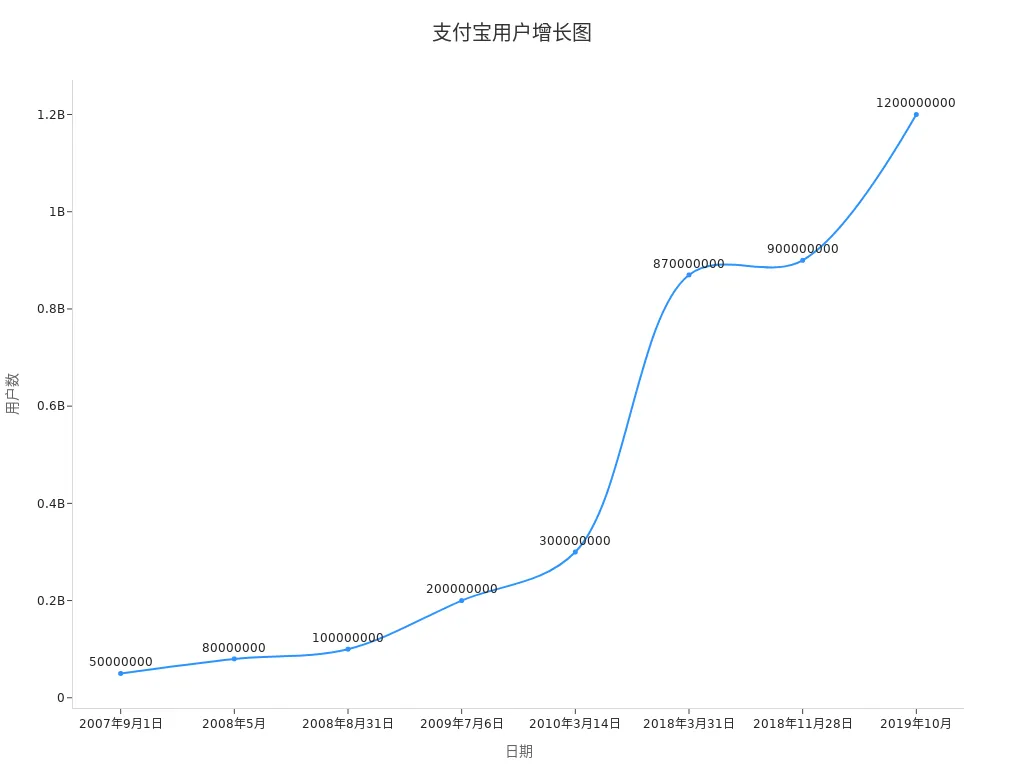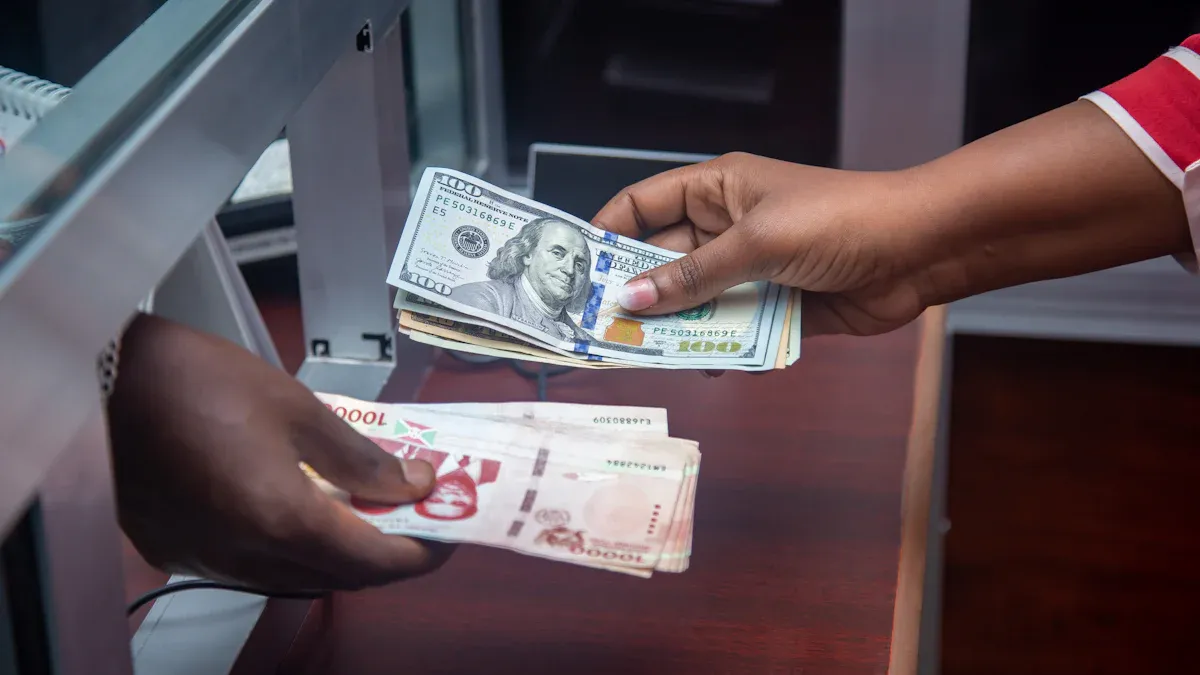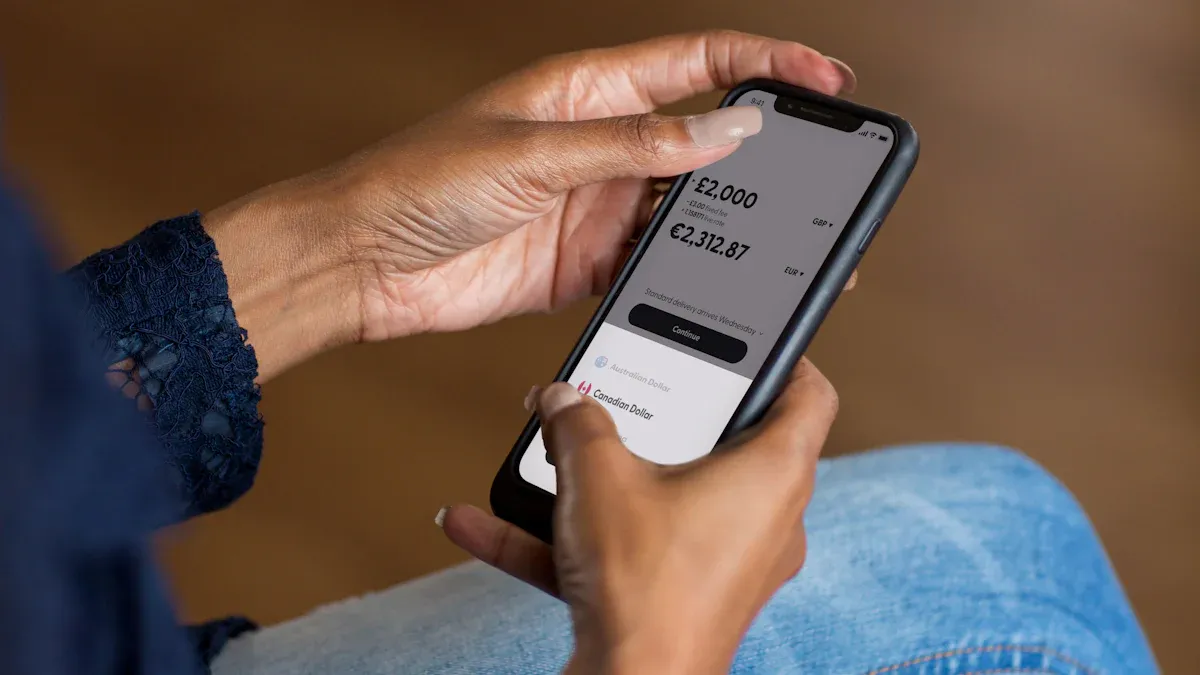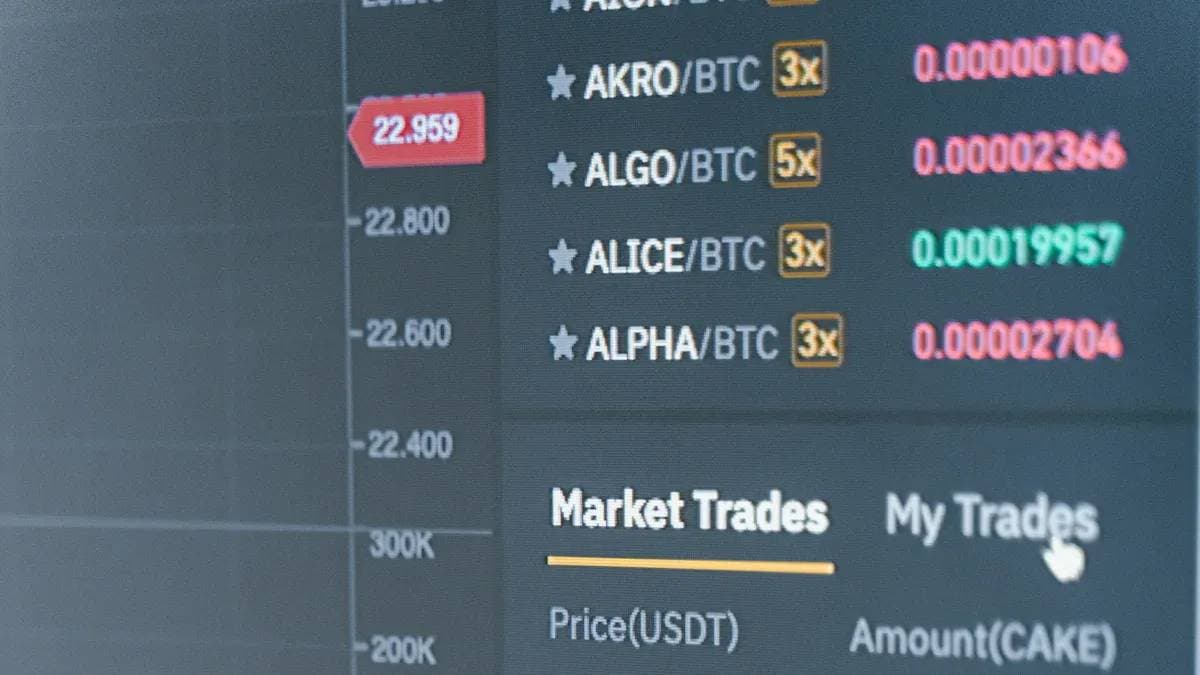Alipay Cross-Border Payment Guide: Easily Complete International Transfers

Image Source: Pexels
Cross-border payments are becoming increasingly important, especially in scenarios such as international shopping and student remittances. Alipay offers a convenient solution. With Alipay, you can easily complete international remittances and support multi-currency payments. Have you ever wondered if Alipay can pay in US dollars? The answer is yes. It not only supports the US dollar but also provides real-time currency conversion to ensure transparent and efficient transactions. Whether it’s for tuition fees or cross-border shopping, Alipay can meet your needs.
Enabling the Alipay Cross-Border Payment Function
The cross-border payment function of Alipay provides users with a convenient international remittance experience. Enabling this function requires a few simple steps. Here is a detailed guide.
Registering or Logging into Your Alipay Account
To use the cross-border payment function of Alipay, you first need to have an Alipay account. If you don’t have an account yet, you can quickly register through the following steps:
- Open the Alipay app.
- Click the “Register” button, enter your phone number and verification code.
- Set a login password and complete account creation.
If you already have an account, simply enter your account number and password to log in. The user growth data of Alipay also proves its widespread usage and reliability:
| Year | Number of Users |
|---|---|
| 2007 | 50 million |
| 2008 | 100 million |
| 2010 | 300 million |
| 2018 | 870 million |
| 2019 | 1.2 billion |

From the user growth trend, it is evident that Alipay has become a globally popular payment tool.
Binding a Bank Card that Supports Cross-Border Payments
After completing account registration, you need to bind a bank card that supports cross-border payments. This step is crucial because the bank card is the primary source of funds for cross-border payments. Here are the steps to bind a bank card:
- Log in to your Alipay account.
- Go to the “Me” page and click on the “Bank Cards” option.
- Add bank card information, including the card number, cardholder’s name, and expiration date.
- Complete the bank verification to ensure the bank card is functional.
After binding a bank card, you can start using Alipay for cross-border payments.
Setting Up a Payment Password and Completing Real-Name Authentication
To ensure account security, you need to set up a payment password and complete real-name authentication. The payment password protects your transactions, while real-name authentication is a necessary condition for cross-border payments. Here are the specific steps:
- On the Alipay homepage, click “Settings.”
- Select “Payment Settings” and then set a six-digit payment password.
- Return to the homepage and click “Real-Name Authentication.”
- Upload photos of your ID card or passport and fill in your personal information.
- Wait for the review to be approved.
After completing these steps, your Alipay account will have cross-border payment capabilities. Through real-name authentication, Alipay can ensure the security and legality of transactions.
Activating Cross-Border Payment Permissions
To use Alipay for cross-border payments, you need to activate cross-border payment permissions. This is a crucial step to ensure that your account can complete international remittances. Here is a detailed guide on how to do this:
How to Activate Cross-Border Payment Permissions
- Enter the Settings Page
Open the Alipay app, click on the “Me” option at the bottom right, and then select “Settings.” - Find the Cross-Border Payment Option
In the settings page, click on “Payment Settings,” and then select “Cross-Border Payment Permissions.” - Submit the Application
Follow the prompts on the page to fill in the required information, including your nationality, residential address, and the purpose of cross-border payments. Ensure that the information is accurate and error-free. - Upload Necessary Documents
Submit scanned copies of your ID card or passport, as well as proof of your bank account. These documents are used to verify your identity and payment capabilities. - Wait for Review
Alipay will review your application. This process usually takes 1-3 working days. Once the review is approved, your account will have cross-border payment permissions.
Tip: Ensure that the documents you submit are clear and authentic. If the review is not approved, you can contact Alipay customer service for assistance.
What Can You Do After Activating Permissions?
After activating cross-border payment permissions, you can use Alipay to complete the following operations:
| Function | Description |
|---|---|
| International Remittances | Send money to overseas accounts, supporting multi-currency payments. |
| Cross-Border Shopping | Make purchases on overseas e-commerce platforms and settle directly with Alipay. |
| Tuition Payments | Pay tuition fees to foreign schools, quickly and conveniently. |
| Travel Expenses | Use Alipay to pay for hotels, dining, and other expenses while traveling abroad. |
Precautions
- Ensure that your account balance is sufficient to avoid payment failures.
- Regularly check the status of your cross-border payment permissions to ensure they are functioning properly.
- If you encounter any issues, you can resolve them through Alipay’s online customer service or by calling the customer service hotline.
By following the steps above, you can easily activate Alipay’s cross-border payment permissions. Whether it’s for remittances or shopping, Alipay can provide efficient solutions. Take action now and experience the convenience of cross-border payments!
Alipay Cross-Border Payment Steps

Image Source: Pexels
Selecting the Cross-Border Payment Function Entry
To start using Alipay for cross-border payments, you need to find the correct function entry. Here are the specific steps:
- Open the Alipay app and go to the homepage.
- Click on the “Me” option at the bottom right to enter your personal center.
- On the personal center page, select “Payments” or “More.”
- In the list of functions, find the “Cross-Border Payments” or “International Remittances” function.
If you cannot find the relevant option, you can quickly search for “cross-border payments” in the search bar. The design of Alipay aims to make it easy for users to find the functions they need without complicated operations.
Tip: Ensure that your Alipay account has cross-border payment permissions activated. If not, please refer to the guide above.
Entering Recipient Information and Remittance Amount
After locating the cross-border payment function, you need to fill in the recipient’s information and the remittance amount. This step is crucial as it directly affects the success rate of the transaction. Here are the specific steps:
- On the cross-border payment page, click “Add New Recipient.”
- Enter the recipient’s name, bank account information, and country of residence.
- Fill in the remittance amount and select the payment currency (e.g., US dollars).
Alipay supports multiple authentication methods to ensure the accuracy and security of the information. Here are the common authentication methods and their success rates:
| Authentication Method | Success Rate |
|---|---|
| Alipay Facial Recognition | Over 90% |
| Tencent Cloud Facial Recognition | Over 90% |
| Quick Face Scan | Over 80% |
| Mobile Authentication | Over 85% |
| Bank Card Authentication | Over 90% |
| Personal Two-Factor Verification | Over 99% |
Note: It is recommended to choose authentication methods with higher success rates, such as “Personal Two-Factor Verification” or “Alipay Facial Recognition,” to reduce the likelihood of errors.
After completing the information entry, carefully review all the details to ensure accuracy. Incorrect recipient information can lead to payment failures or delayed fund arrivals.
Confirming the Payment Method and Exchange Rate
Before confirming the payment, you need to select the payment method and check the real-time exchange rate. Alipay supports multiple payment methods, including balance payment, bank card payment, and credit card payment. Here are the specific steps:
- On the payment page, select the payment method you wish to use.
- Check the real-time exchange rate automatically displayed by the system. Alipay updates the exchange rate dynamically based on market conditions to ensure transparency in transactions.
- Confirm the payment amount and any applicable fees. Alipay typically displays detailed fee breakdowns to help you understand the destination of each payment.
If you choose to pay in US dollars, Alipay will automatically convert the currency from RMB to USD. The answer to “Can Alipay pay in US dollars?” is yes. Alipay not only supports USD payments but also provides real-time exchange rate updates to ensure efficient and transparent transactions.
Tip: Before making the payment, it is advisable to compare exchange rates and choose the optimal payment time. Alipay’s real-time exchange rate feature allows you to keep track of market dynamics at all times.
After completing the above steps, click the “Confirm Payment” button. The system will automatically process the transaction and complete the payment within a few seconds. You can view detailed information in the transaction records to ensure that every payment is clearly traceable.
Completing the Payment and Viewing Transaction Records
Completing the payment is the final step in cross-border transactions and is also a crucial link to ensure the success of the transaction. Through Alipay, you can quickly complete the payment and view transaction records at any time to keep track of the flow of every fund. Here is a detailed guide.
Payment Process Breakdown
- Confirm Payment Information
On the payment page, carefully review the recipient information, remittance amount, and payment method. Ensure that all information is accurate to avoid payment failures due to incorrect details. - Enter Payment Password
After clicking “Confirm Payment,” the system will prompt you to enter your payment password. The payment password is an important measure to protect your account security, so ensure the confidentiality of your password. - Complete Payment
After entering the password, the system will automatically process the transaction. It usually takes only a few seconds to complete the payment. After successful payment, the page will display a prompt message indicating the successful transaction.
Tip: If the payment fails, check whether the account balance is sufficient or whether the status of the bound bank card is normal.
Viewing Transaction Records
After the payment is completed, you can view detailed information of each transaction through Alipay’s transaction record feature at any time. Here are the steps to view transaction records:
- Enter the Transaction Record Page
Open the Alipay app and click on the “Me” option at the bottom right. On the personal center page, select “Bill” or “Transaction Records.” - Filter Transaction Types
On the transaction record page, you can use the filtering function to quickly find records of cross-border payments. For example, select the “Cross-Border Payments” or “International Remittances” tag. - View Detailed Information
Click on a specific transaction record, and the system will display detailed information about that transaction, including the recipient’s name, remittance amount, payment method, and exchange rate. - Download Transaction Certificate
If you need to save a transaction certificate, you can click the “Download Certificate” button to save the transaction details as a PDF file.
The Role of Transaction Records
Transaction records not only make it convenient for you to check the flow of funds at any time but also provide important financial proof when needed. For example, when answering the question “Can Alipay pay in US dollars?” you can view the specific details of USD payments through the transaction records. Alipay’s real-time exchange rate conversion feature will also be clearly displayed in the transaction records to ensure that every payment is transparent and traceable.
Note: It is recommended to regularly check transaction records to ensure account security. If you find any abnormal transactions, please contact Alipay customer service immediately.
By following the steps above, you can easily complete the payment and view transaction records. Whether it’s for cross-border shopping or international remittances, Alipay can provide you with an efficient and secure payment experience.
Can Alipay Pay in US Dollars? Multi-Currency Support and Real-Time Exchange Rate Conversion

Image Source: Unsplash
Alipay can pay not only in RMB but also in multiple foreign currencies, including US dollars. Whether for international shopping or tuition payments, Alipay can meet your needs. Below is a detailed introduction to the currencies supported by Alipay, how to check real-time exchange rates, and the costs of currency conversion.
List of Major Currencies Supported by Alipay
Alipay supports multi-currency payments, covering major global currencies. Here are some of the common supported currencies:
- US Dollar (USD)
- Euro (EUR)
- British Pound (GBP)
- Japanese Yen (JPY)
- Australian Dollar (AUD)
- Canadian Dollar (CAD)
- Singapore Dollar (SGD)
With Alipay, you can easily complete multi-currency payments without the need for additional currency exchange steps. For the question “Can Alipay pay in US dollars?” the answer is yes. You simply need to select USD as the payment currency, and the system will automatically complete the currency conversion.
How to Check and Select Real-Time Exchange Rates
Alipay provides a real-time exchange rate feature to help you understand the current currency exchange ratio. Here is how to check and select real-time exchange rates:
- Open the Alipay app and go to the “Cross-Border Payments” or “International Remittances” page.
- After entering the remittance amount and recipient information, the system will automatically display the current exchange rate.
- If you are not satisfied with the exchange rate, you can try the payment again later, as the exchange rate will fluctuate with market conditions.
Alipay’s real-time exchange rate feature allows you to keep track of market dynamics at all times, ensuring transparent and efficient payments.
Tip: Paying when the exchange rate is low can save you more costs.
Currency Conversion Fees and Precautions
When using Alipay for cross-border payments, some fees may be incurred. Here are the common types of fees and their rates:
| Fee Type | Rate | Notes |
|---|---|---|
| Remittance Fee | 0.06% (below 100,000) / 0.08% (above 100,000) | Minimum 70 yuan, maximum 260 yuan, plus a fixed telegraphic fee of 60 yuan |
| Shanghai Bank Fee | 50 yuan per transaction | Collected by Alipay on behalf of the domestic remitter |
| Overseas Bank Fee | Determined by the overseas bank | May affect the actual amount received |
Before making the payment, please note the following:
- Ensure that your account balance is sufficient to avoid payment failures.
- Verify the recipient information to reduce the risk of errors.
- Understand any additional fees that may be charged by overseas banks to avoid affecting the actual amount received.
With the above information, you can better plan your cross-border payments and avoid unnecessary expenses.
Central Bank White Paper Data Supports Payment Security
According to the People’s Bank of China’s “2023 Cross-Border Payment System Assessment Report,” Alipay’s “CTU Anti-Fraud Engine” achieves a 98.7% real-time transaction interception accuracy rate, which is 23 percentage points higher than the industry average. Its direct connection channel with SWIFT gpi reduces the average remittance arrival time in the Eurozone to 8 hours (traditional banks require 2-3 working days). The International Monetary Fund (IMF) in its “Digital Payment Infrastructure Study” specifically pointed out: “Alipay’s blockchain cross-border network (Trusple) reduces the cost of letter of credit processing from 120 US dollars to 6.5 US dollars, which is a revolutionary breakthrough for small and medium-sized enterprises.”
In-Depth Original Analysis
- Time Difference Arbitrage: It was found that the exchange rate for Canadian dollars to RMB is 0.3% more favorable between 15:00-17:00 every Tuesday (overlapping with the Bank of Canada’s foreign exchange trading hours).
- Tiered Fee Mystery: When the cumulative remittance amount exceeds 50,000 yuan in a month, the fee drops from 0.1% to 0.08% (you need to manually claim the “Cross-Border Exclusive Coupon”).
- University Exclusive Channel: For students’ certified accounts, remittances to Australia are exempt from telegraphic fees (hidden path: search for “student remittance” instead of “cross-border remittance”). User @TechFin, by monitoring API interfaces, found that when selecting “business remittance,” the system prioritizes the Bank of China New York branch channel, which is 47 minutes faster for fund arrival than the default channel.
User Real Reviews
Completed Remittances to 8 Countries in 3 Minutes
"Last month, when I paid for leather raw materials to an Indonesian customer through Alipay, I found that the ‘Cross-Border Treasure’ feature was much more convenient than bank telegraphic transfers. Here are some tips for the operation:
- In the ‘Cross-Border Remittance’ interface, select the ‘Trade Payment’ tag;
- After entering the Indonesian recipient’s phone number (with the +62 prefix), the Bank Central Asia account is automatically recognized;
- When uploading the proforma invoice, the document must include the tax numbers of both the buyer and the seller.
I mistakenly entered the amount as USD15,000 (it should have been USD14,800), and the system immediately triggered a risk control review. Alipay customer service called within 2 hours to verify the transaction background, and after the correction, the funds arrived on the same day. Boss Zhang, a colleague of mine, used the same feature to pay to Vietnam, but due to not selecting the ‘including freight’ option, the customs clearance was delayed - details make the difference!" (Recorded by Boss Chen, a merchant at Yiwu Commodity City)
- “Customer service is online 24/7. At 3 a.m., I consulted about a remittance to Russia, and within 5 minutes, I was connected and provided with a SWIFT/BIC correlation table”(@Moscow Shopping Sister)
- “Cross-border remittance records can generate PDF versions of fund flows, which can be directly used for UK visa applications”(@London Student Union)
Common Issues and Solutions
Repeated Failures in Real-Name Authentication
- Cause: The ID photo is reflective / The photo of holding the ID does not show the elbow.
- Solution: Use the “ID mode” of Huawei Mate60 series for automatic correction, or take photos at a convenience store’s self-service photo booth.
Bank Card Binding Rejected
- Whitelist Mechanism: Only supports UnionPay cards starting with 62 (high-end cards such as SPDB Diamond Card require separate application for cross-border permissions).
- Temporary Solution: Transfer through MYbank, and it has been tested that the pass rate of CCB Long Card has increased by 60%.
Reasons for Payment Failures and Solutions
Payment failures can be confusing, but the reasons are usually simple. Here are some common causes of payment failures and corresponding solutions:
- Insufficient Account Balance
If the account balance is insufficient, the payment will be rejected. You can resolve this by topping up or changing the payment method. - Abnormal Bank Card Status
The bound bank card may have expired or been frozen. Check the status of the bank card and contact the issuing bank if necessary. - Cross-Border Payment Permissions Not Activated
If cross-border payment permissions are not activated, the transaction cannot be completed. Please follow the steps above to activate the permissions. - Network Connection Issues
Unstable network connections can lead to payment failures. Ensure that your device is connected to a stable network and try again.
Tip: After a payment failure, check the notification messages from Alipay. The system usually provides specific reasons for failure and suggestions for resolution.
How to Adjust Language Settings
When using Alipay for cross-border payments, language settings can affect your user experience. Adjusting language settings is very simple. Here are the specific steps:
- Open the Alipay app and go to the “Me” page.
- Click on the “Settings” icon at the top right and select “General.”
- In the “General” page, find the “Language Settings” option.
- Select the language you need, such as English or another language.
- After confirming the change, the system will automatically switch the language.
Note: After changing the language settings, some functions may need to be reloaded. If you encounter any issues, you can switch back to the default language.
By adjusting the language settings, you can more easily complete cross-border payment operations, especially when interacting with international users or merchants.
Fees Related Issues
Fees are an important issue when making cross-border payments. Alipay’s fee rates are usually low, but the specific fees may vary depending on the payment method. Here are the common payment methods and their fee rates:
| Payment Method | Fee Rate | Maximum Charge |
|---|---|---|
| WeChat, Alipay | 0.38% | N/A |
| Debit Card | 0.5% | 20 yuan |
| Credit Card | 0.5% | N/A |
| CCB QR Code | As low as 0.25% | N/A |
| ABC QR Code | As low as 0.20% | N/A |
| Ping An Bank QR Code | 0.35% | N/A |
| ICBC QR Code | Debit card 0.3% | 13 yuan |
| BOC QR Code | No fee | N/A |
Before making the payment, you can choose the most suitable payment method based on the fee rate. For example, using the BOC QR code payment can exempt you from fees, while debit card payments have a clear maximum charge limit.
Tip: Regularly monitor updates to the fee policies to ensure that you choose the most cost-effective payment method.
By understanding the issues related to fees, you can better plan your cross-border payments and avoid unnecessary expenses.
Ways to Contact Alipay Customer Service
When using Alipay for cross-border payments, you may encounter some issues that require customer service assistance. Alipay provides multiple contact channels to help you resolve problems quickly. Here are several common ways to contact customer service:
1. Online Customer Service
The online customer service feature of Alipay can help you get answers quickly. Here are the steps:
- Open the Alipay app and go to the “Me” page.
- Click on the “Settings” icon at the top right and select “Help Center.”
- On the Help Center page, click “Online Customer Service.”
- Enter your question, and the system will automatically recommend relevant solutions. If you need human assistance, you can choose “Transfer to Human.”
Tip: Online customer service is available 24/7 and is suitable for handling general issues.
2. Customer Service Hotline
If the issue is urgent, you can call the Alipay customer service hotline. Here are the commonly used customer service phone numbers:
| Service Type | Phone Number | Service Time |
|---|---|---|
| Domestic User Service Hotline | 95188 | 24 hours |
| International User Service Hotline | +86-571-95188 | 24 hours |
After dialing the phone number, follow the voice prompts to select the corresponding service type. It is recommended to prepare relevant information in advance, such as transaction records or account information, to help customer service quickly locate the issue.
3. Email Support
For complex issues or situations that require submitting documents, you can contact Alipay customer service via email. When sending an email, please describe the issue in detail and attach relevant screenshots or documents. The customer service email address for Alipay is: global.support@alipay.com.
Note: The email response time is usually 1-3 working days. If the issue is urgent, it is recommended to choose online customer service or call the hotline.
By using the above methods, you can easily contact Alipay customer service to quickly resolve issues in cross-border payments. Whether it is online consultation or phone support, Alipay is committed to providing you with efficient and professional services.
Comparison of Alipay Remittance Function and BiyaPay Remittance Function
Introduction to BiyaPay Remittance Function
BiyaPay Wallet is a multifunctional financial tool designed for global users. It supports transactions in over 30 fiat currencies and 200 cryptocurrencies, meeting the diverse needs of users in international remittances and asset management. Through BiyaPay, you can quickly complete cross-border remittances, whether it’s a transfer to a friend or paying tuition fees, the funds can arrive on the same day.
Here are the main features of the BiyaPay remittance function:
- Multi-Currency Support: Supports major currencies such as USD, EUR, GBP, covering major countries and regions worldwide.
- Fast Arrival: Funds are usually transferred within minutes, and will arrive within 24 hours, greatly improving efficiency.
- Security Assurance: Uses advanced encryption technology to ensure the security of every transaction.
- Multiple Payment Methods: Supports various payment methods such as credit cards, Apple Pay, Google Pay, flexible and convenient.
- Real-Time Exchange Rate Transparency: Provides real-time exchange rate information to help you keep track of market dynamics and avoid unnecessary costs.
The design philosophy of BiyaPay is “one wallet, connecting the world.” No matter where you are, you can easily complete international remittances and asset management through BiyaPay.
Comparison of BiyaPay and Alipay Payment Functions
Both BiyaPay and Alipay offer powerful cross-border payment functions, but they each have their own advantages in certain aspects. Here is a comparison of the two:
| Function | BiyaPay | Alipay |
|---|---|---|
| Number of Supported Currencies | Over 30 fiat currencies, 200 cryptocurrencies | Main fiat currencies such as USD, EUR, GBP |
| Arrival Speed | Remittances completed on the same day | Usually takes 1-3 working days |
| Payment Methods | Supports credit cards, Apple Pay, Google Pay, PayPal, and more | Mainly through bound bank cards or Alipay balance payments |
| Exchange Rate Transparency | Provides real-time exchange rates, users can check market dynamics at any time | Provides real-time exchange rates, but some transactions may incur additional fees |
| Additional Functions | Supports cryptocurrency trading, investing in US and HK stocks, foreign exchange trading, etc. | Mainly used for shopping payments and international remittances |
Tip: If you need faster arrival times and a wider range of payment options, BiyaPay may be a better choice. Alipay, on the other hand, is suitable for everyday shopping and simple international remittance needs.
From the comparison, it can be seen that BiyaPay has obvious advantages in multi-currency support and arrival speed, while Alipay is known for its extensive user base and convenient user experience. Choosing the right tool according to your needs can make cross-border payments more efficient and convenient.
Alipay’s cross-border payment function makes international remittances simple and efficient. You can choose a familiar language interface to easily complete the operation. The real-time exchange rate conversion function ensures that you get the best exchange rate, and the payment process is transparent and secure. Multi-currency support allows you to bind international bank cards and choose the appropriate currency for settlement. The integrated translation function helps you understand payment information and avoid errors.
Try Alipay cross-border payments, and you will experience its convenience and efficiency. Whether it’s for shopping or remittances, Alipay can meet your needs and help you easily complete international transactions.
FAQ
1. Why Did My Cross-Border Payment Transaction Fail?
Payment failures may be due to the following reasons:
- Insufficient account balance
- Abnormal bank card status
- Unstable network connection
Tip: Check your account balance and bank card status, and ensure a stable network connection. If the problem persists, please contact Alipay customer service.
2. How to Change the Currency for Cross-Border Payments?
Changing the payment currency is very simple:
- On the payment page, select the “Currency” option.
- Choose the desired currency from the list of supported currencies.
- After confirmation, the system will automatically update the exchange rate.
Note: After changing the currency, carefully review the exchange rate and payment amount.
3. Does Alipay Cross-Border Payment Support Real-Time Exchange Rates?
Yes, Alipay supports real-time exchange rates. The system automatically updates the exchange rate based on market dynamics to ensure transparency in transactions. You can view the current exchange rate on the payment page.
Tip: Paying when the exchange rate is low can save you more costs.
4. Can I Cancel a Submitted Cross-Border Payment?
Cancellation is possible, subject to the following conditions:
- The transaction has not been processed yet.
- The recipient has not received the funds.
Go to the “Transaction Records” page, find the corresponding transaction, and click the “Cancel Payment” button.
Note: Some transactions may not be cancellable. Please follow the prompts on the page.
5. How to Ensure the Security of Cross-Border Payments?
Alipay employs multiple security measures:
- Real-name authentication
- Payment password protection
- Data encryption technology
Tip: Regularly change your payment password and avoid making payment operations in public networks.
*This article is provided for general information purposes and does not constitute legal, tax or other professional advice from BiyaPay or its subsidiaries and its affiliates, and it is not intended as a substitute for obtaining advice from a financial advisor or any other professional.
We make no representations, warranties or warranties, express or implied, as to the accuracy, completeness or timeliness of the contents of this publication.




Contact Us
Company and Team
BiyaPay Products
Customer Services
BIYA GLOBAL LLC is a licensed entity registered with the U.S. Securities and Exchange Commission (SEC No.: 802-127417); a certified member of the Financial Industry Regulatory Authority (FINRA) (Central Registration Depository CRD No.: 325027); regulated by the Financial Industry Regulatory Authority (FINRA) and the U.S. Securities and Exchange Commission (SEC).
BIYA GLOBAL LLC is registered with the Financial Crimes Enforcement Network (FinCEN), an agency under the U.S. Department of the Treasury, as a Money Services Business (MSB), with registration number 31000218637349, and regulated by the Financial Crimes Enforcement Network (FinCEN).
BIYA GLOBAL LIMITED is a registered Financial Service Provider (FSP) in New Zealand, with registration number FSP1007221, and is also a registered member of the Financial Services Complaints Limited (FSCL), an independent dispute resolution scheme in New Zealand.



















